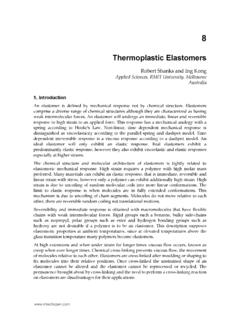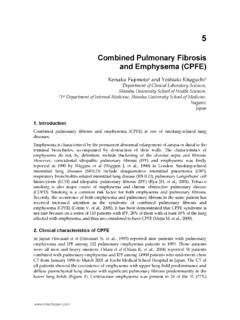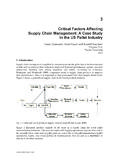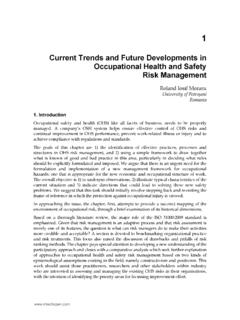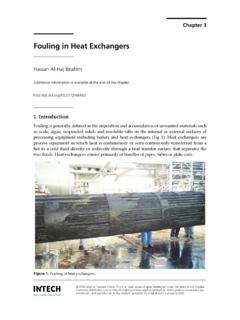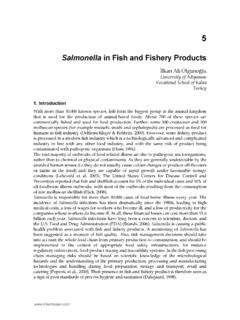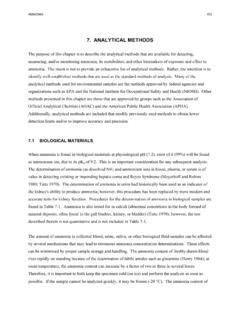Transcription of Derivatization Reactions and Reagents for Gas ...
1 5. Derivatization Reactions and Reagents for Gas chromatography analysis Francis Orata Masinde Muliro University of Science and Technology, Kenya 1. Introduction Derivatization Reactions are meant to transform an analyte for detectability in Gas chromatography (GC) or other instrumental analytical methods. Derivatization in GC. analysis can be defined as a procedural technique that primarily modifies an analyte's functionality in order to enable chromatographic separations. A modified analyte in this case will be the product, which is known as the derivative. The derivative may have similar or closely related structure, but not the same as the original non-modified chemical compound.
2 Volatility of sample is a requirement for GC analysis . Derivatization will render highly polar materials to be sufficiently volatile so that they can be eluted at reasonable temperatures without thermal decomposition (Knapp, 1979) or molecular re-arrangement (K hnel et al., 2007; Blau and King 1979). Understanding the chemistry of the analytes, derivatizing Reagents used in sample preparation, and the detailed functionality of Gas chromatography are important to get reliable results. For GC analysis , compounds containing functional groups with active hydrogens such as -SH, -OH, -NH and -COOH are of primary concern because of the tendency of these functional groups to form intermolecular hydrogen bonds (Zaikin and Halket, 2003).
3 These intermolecular hydrogen bonds affect the inherent volatility of compounds containing them, their tendency to interact with column packing materials and their thermal stability (Sobolevsky et al., 2003). Since GC is used to separate volatile organic compounds, modification of the functional group of a molecule by Derivatization enables the analysis of compounds that otherwise can not be readily monitored by GC. Derivatization process either increases or decreases the volatility of the compound of interest. It also reduces analyte adsorption in the GC system and improves detector response, peak separations and peak symmetry. In addition to particular analytes such as pharmaceuticals, biomolecules such us organic acids, amides, poly-hydroxy compounds, amino acids, pesticides and other persistent organic compounds, new classes of compounds of interest for example fluorinated alkylated substances and polycyclic aromatic hydrocarbons continue to emerge.
4 It is necessary to develop and/or improve on chemical analytical methods and hence the need to familiarize with Derivatization methods that are applicable to GG analysis . Generally Derivatization is aimed at improving on the following aspects in Gas chromatography . 84 Advanced Gas chromatography Progress in Agricultural, Biomedical and Industrial Applications i. Suitability Suitability is the form of compounds that is amenable to the analytical technique. For GC, it is a requirement that the compound to be analyzed should be volatile with respect to gas chromatographic analysis conditions, as compared to liquid chromatography (LC), where the compound of interest should be soluble in the mobile phase.
5 Therefore, Derivatization procedure modifies the chemical structure of the compounds so that they can be analyzed by the desired technique. ii. Efficiency Efficiency is the ability of the compound of interest to produce good peak resolution and symmetry for easy identification and practicability in GC analysis . Interactions between the compounds themselves or between the compounds and the GC column may reduce the separation efficiency of many compounds s and mixtures (Knapp, 1979). Derivatization of analyte molecules can reduce these interactions that interfere with analysis . Also, compounds that co-elute or have poor resolution from other sample components during separation in GC can frequently be resolved by an appropriate derivative.
6 Iii. Detectability Detectability is the outcome signal that emanates from the interaction between the analyte and the GC detector. Increasing the amounts of materials will impact the range at which they can be detected in Gas chromatography . This can be achieved either by increasing the bulk of the compound or by introducing onto the analyte compound, atoms or functional groups that interact strongly with the detector and hence improve signal identification. For example the addition of halogen atoms to analyte molecules for electron capture detectors (ECD) and the formation of trimethylsilyl (TMS) ether derivatives to produce readily identifiable fragmentation patterns and mass ions (Knapp, 1979).
7 Derivatization reagent Derivatization reagent is the substance that is used to chemically modify a compound to produce a new compound which has properties that are suitable for analysis in GC or LC. The following criteria must be used as guidelines in choosing a suitable Derivatization reagent for GC analysis . i. The reagent should produce more than 95 % complete derivatives. ii. It should not cause any rearrangements or structural alterations of compounds during formation of the derivative. iii. It should not contribute to loss of the sample during the reaction. iv. It should produce a derivative that will not interact with the GC column. v. It should produce a derivative that is stable with respect to time.
8 Objectives for Derivatization The following outlined objectives among others can be achieved by application of proper Derivatization procedures;. i. Improvement of resolution and reduce tailing of polar compounds which may contain . OH, COOH, =NH, NH2, SH, and other functional groups. Derivatization Reactions and Reagents for Gas chromatography analysis 85. ii. analysis of relatively nonvolatile compounds. iii. Reduction of volatility of compounds prior to GC analysis . iv. Improvement of analytical efficiency and hence increase detectability. v. Stabilization of compounds for GC analysis . 2. Types of Derivatization Reactions Derivatization Reactions used for gas chromatography (GC) fall into three general reaction types namely; Alkylation of which the general process is esterification, Acylation and Silylation.
9 Through these three processes, highly polar materials such as organic acids, amides, poly-hydroxy compounds, amino acids are rendered suitable for GC analysis by making them sufficiently volatile. These general processes are discussed below. Alkylation Alkylation is mostly used as the first step for further derivatizations or as a method of protection of certain active hydrogens in a sample molecule. It represents the replacement of active hydrogen by an aliphatic or aliphatic-aromatic ( , benzyl) group in process referred to as esterification. Equation 1 below shows the general reaction equation representing the esterification process. RCOOH + PhCH2X RCOOCH2Ph + HX.
10 Equation 1: General reaction for esterification process: X = halogen or alkyl group R, H =. another alkyl group R. The principal chromatographic use of this reaction is the conversion of organic acids into esters, especially methyl esters that produce better chromatograms than the free acids. Alkylation Reactions can also be used to prepare ethers, thioethers and thioesters, N- alkylamines, amides and sulphonamides (Danielson, 2000). In general, the products of alkylation are less polar than the starting materials because active hydrogen has been replaced by an alkyl group. The alkyl esters formed offer excellent stability and can be isolated and stored for extended periods if necessary.


